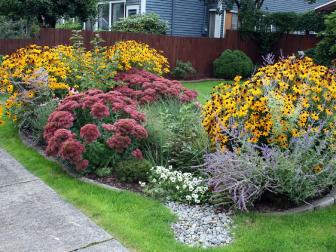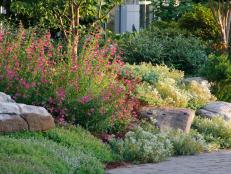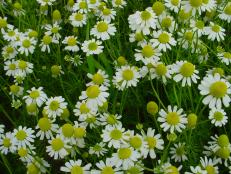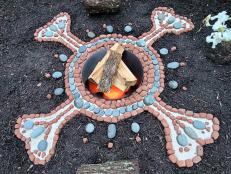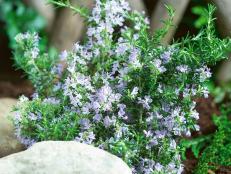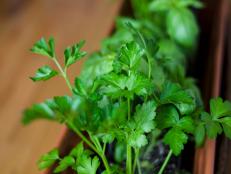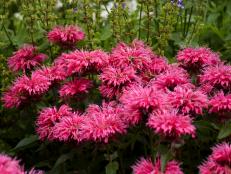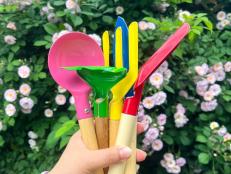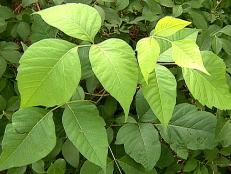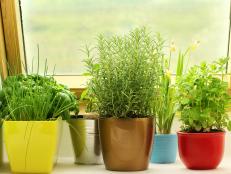How to Create a Rain Garden in Your Yard
Do your part to save natural water resources by planting a rain garden. Learn about this easy-to-grow, clever concept.
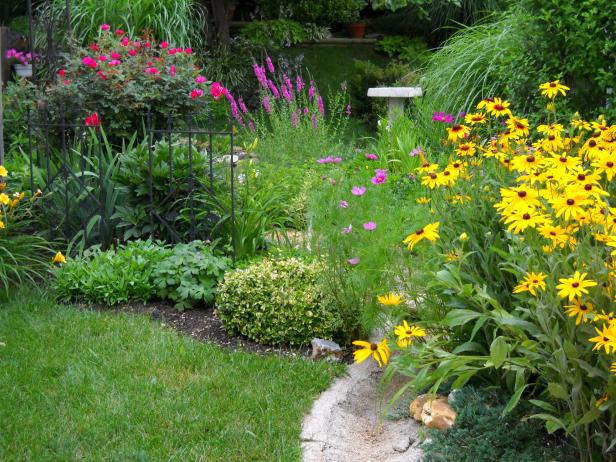
A rain garden is a mixed planting of deeply rooted perennials, grasses and even some woody shrubs designed to capture stormwater runoff and hold it in place until it is either absorbed by plants, evaporates from the garden or infiltrates into the soil.

A beautiful flower garden is nice, but one that pulls its weight in the landscape is even better. Rain gardens capture rainwater as it flows away from homes and pavement and allows water to infiltrate the soil rather than contribute to often overburdened municipal stormwater systems.
Rain gardens work hard and look pretty while they do it, often brimming with gorgeous perennial flowers, ornamental grasses and even woody shrubs that help soak up water runoff.
Why Build a Rain Garden?
Does it seem like flooding occurs more often in your area? While the US Environmental Protection Agency confirms that heavy downpours have increased in intensity and frequency, there are other factors beyond the amount of rain that can have an impact on local flooding.
Development is on the rise, which means there are more impervious surfaces like pavement and roofs that carry water directly to stormwater systems. Fields and wooded areas are cleared for new development, and areas that aren’t paved are usually planted with lawns that are less able to slow the flow of stormwater than the heavily vegetated areas they replaced. Flooding isn’t the only problem with stormwater runoff, as it often carries chemicals from leaking cars, lawn fertilizers, animal waste and other pollutants into local waterways.
Rain gardens are one important way to capture runoff and allow it to percolate into the soil rather than contribute to stormwater systems that are often already overwhelmed. When properly designed and constructed, a rain garden can be a beautiful and functional part of the landscape.
What is a Rain Garden?
A rain garden is a mixed planting of deeply rooted perennials, grasses and even some woody shrubs. Rain garden beds are created in slight depressions that are designed to capture stormwater runoff and hold it in place until it is either absorbed by plants, evaporates from the garden or infiltrates into the soil. The size and depth of the bed depends on both the soil quality and how much rainwater needs to be captured.
10 Rain Garden Design Ideas 10 Photos
Want to do your bit to help save the planet? Consider adding a rain garden to your yard. Check out these designs for inspiration.
A rain garden may fill up completely after a heavy rain, but a properly designed rain garden should fully drain within 24 hours. In fact, for most of the year your rain garden may actually be very dry. That’s a good thing, because nobody wants to create a mosquito habitat in their yard. Mosquito larvae need seven to 12 days in standing water to develop from an egg to an adult, which means that your rain garden will be too dry for them to reproduce.
How to Build a Rain Garden
1. Find the Right Spot
First and foremost, a rain garden needs to be in a spot that can capture stormwater runoff. Choosing the right location is what sets your functional rain garden apart from just another flower bed. The next time it rains, go outside and observe how the water moves across your yard. Look for a spot where water moves but does not pond. Remember, your goal is for water to infiltrate into the soil, and ponding is a sign of poor drainage.
Choose a spot that is at least 10 feet away from your house to prevent any water damage to your home or foundation. Avoid digging where there are underground utilities or septic systems. If you’re not sure where your water, sewer, gas and other utilities lines run, always call 811 before you dig. Your state’s 811 service should be able to help you flag the utility lines in your yard.
When you think that you’ve found the perfect spot, look up. Are there any trees overhead? It’s best to avoid digging a rain garden below the canopy of mature trees. Chopping through woody roots is not only difficult, but it also will harm your trees.
Next, do a percolation test. This will give you an idea of how quickly water is able to move through the soil.
- First, dig a hole that is about 1 foot deep.
- Fill the hole completely with water.
- Once the water has fully drained from the hole, fill it up again.
- The amount of time that it takes for the water to drain from the hole is called your “infiltration rate." Ideally between 1 and 3 inches of water should drain from the hole in an hour.
- If it takes longer than an hour for an inch of water to percolate into the soil, you will need to amend the bed to speed up the infiltration rate.
2. Calculate the Right Size and Layout
Both the size of your roof and other impervious surfaces as well as the type of soil in your garden will determine the ultimate size of your rain garden.
Measure Impervious Surfaces That Will Feed the Rain Garden: Next, you’ll need to calculate the size of the area that will be draining into the rain garden. If your rain garden is designed to hold runoff from a downspout, take a look at your roof from your yard. Where does the roof pitch? Estimate the size of that portion of the roof. Are there any other impervious surfaces like patios, driveways, greenhouses or sheds that will feed into the rain garden? If yes, estimate the size of those surfaces, too.
Test Your Soil: It’s always a good idea to do a quick soil test before building a new garden. Reach out to your state extension services to learn how to collect a soil sample for testing. Not only can a soil test report tell you the proportions of sand, silt or clay in your garden, it will also assess the amount of organic matter, level of acidity or alkalinity and nutrient levels.
If your soil is sandy or loamy, then your rain garden should be 10% the size of the impervious area that runs into it. For example, a 100-square-foot rain garden would be able to hold water from a 1,000-square-foot section of roof. If your soil has a higher clay content (your soil report may say “silty clay," “sandy clay” or “silty clay loam”), then the rain garden should be 15% the size of the contributing area. To continue the previous example, a rain garden that holds water from a 1,000-square-foot roof should be 150 square feet. These are general estimates that should work in most situations. For more precise calculations, check out “Rain Gardens: A How-To Manual for Home Gardeners” from the University of Wisconsin.
If you think that you have heavy clay soils, you should definitely do a soil test before breaking ground on your new rain garden. Clay soils drain extremely slowly and will need lots of compost and other organic matter mixed in before they can function as a rain garden. Dr. Andrea Ludwig, a stormwater specialist with the University of Tennessee Extension Service, encourages folks who have heavy, tight clay soils to consider a backyard wetland habitat instead of a rain garden.
Decide the Best Layout: Remember, the purpose of your rain garden is to intercept rainwater runoff before it can leave your property. To that end, the shape of your garden in relation to the direction water moves plays an important role in capturing stormwater. A long, skinny garden laid in the same direction as water runoff won’t capture nearly as much as a thin garden placed perpendicular to the direction as water runoff. The longer side of the garden should face upslope.
Rain gardens should be level, which means that gardens built on slopes will need to be narrower for easier construction. Rain gardens built on flat sites can be wider, but experts recommend building a garden that is at least roughly twice as long as it is wide. Ovals, teardrops and bean shapes are popular in rain garden designs.
3. Dig the Garden
Now that you’ve found the best spot, calculated the necessary size and decided on a good shape, it’s time to excavate a spot for the garden. Set the boundaries of the garden with marking flags, marking spray paint or stakes. Use a shovel to lift turf and any exiting vegetation.
The average depth of the garden as a whole should be 6 inches, but the depth can vary from 4 inches on a shallow uphill side down to 7 or 8 inches closer to the base. As you remove soil from the rain garden, mound the excavated soil along the downhill edge and sides of the depression. This low berm will help hold water in the garden. After you finish digging out the garden, use your foot or a shovel to firmly tamp the soil on the berm into place.
Once you’ve dug the bed, it’s time to direct water flow to your new rain garden. Some people prefer to run an underground drain from their downspouts to the rain garden. Others simply dig a very shallow swale to guide water from the downspouts to the rain garden. The swale can be planted with turfgrass so that it blends in with the lawn, or it can be richly planted with more rain garden plants. Regardless of the type of plants used, the swale needs to be planted or heavily mulched to prevent soil from washing away.
4. Add Plants
Your rain garden will need to include plants that are adapted to a variety of soil moisture conditions. The area within the rain garden that takes the longest to drain should be a great spot for plants that will tolerate having wet feet. The raised berm at the base of the rain garden will be much drier than the rest of the landscape for most of the year, which means that area should be planted with drought tolerant plants. The rest of the rain garden should be planted with “mesic” plants that prefer typical soil conditions.
While there are many ornamental plants that work well in a rain garden situation, many rain garden advocates strongly encourage using native plants. Many native species are not only excellent at holding soil and absorbing water, but they also do a great job of supporting the ecosystem in your garden. Native plants support a greater diversity of insects that in turn feed neighborhood songbirds. Gardens planted with natives don’t need to look wild or messy. Follow the same considerations recommended for a well-designed, mixed garden bed including combining various sizes, shapes, textures and complementary colors.
When you finish planting, water plants well then spread a thick layer of mulch over the soil in the bed and on the berm. Keep an eye on water over the first season as plants become established. The rain garden shouldn’t need to be watered after the first growing season.
Rain Garden Plants
Choose a mix of native and ornamental plants for the rain garden. Good choices include the following:
Turtlehead — Chelone glabra grows 24 to 36 inches tall by 18 to 24 inches wide and features white blooms that attract bees, hoverflies and Baltimore checkerspot butterflies, which use the wildflower as a larval food source. Plants are hardy in Zones 3 to 8.
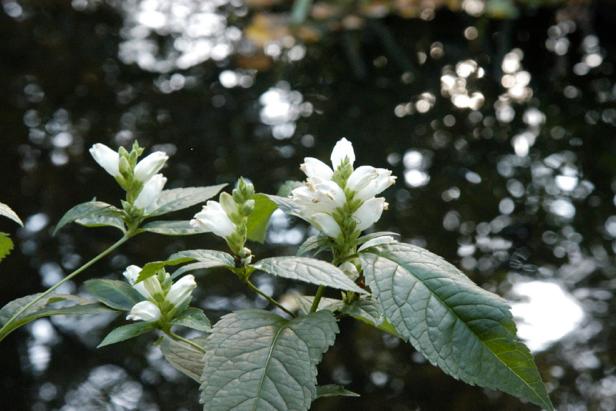
Image courtesy of MtCubaCenter.org
For soggy and wet spots, count on turtlehead for reliable late summer to fall color.
Bee Balm — Bees love Monarda, a full-sun perennial hardy in Zones 4-9. The tube-shaped flowers will bloom in late spring to late summer.
Switch Grass — Tall, trouble-free Panicum virgatum produces clumps of medium-green leaves topped by pinkish flowers starting in late summer. Give the plants full sun to part shade
Blazing Star — The most commonly found gayfeather, Liatris spicata, grows flower spikes that reach 3 to 4 feet tall.

Photo courtesy of Perennial Resource
Liatris spicata ‘Kobold' is a good choice for Southern gardens because it can take the heat.
Purple Coneflower — Rose-purple Echinacea purpurea blossoms appear from mid to late summer. Purple coneflower grows 24 to 60 inches tall and 18 to 24 inches wide. And deer leave purple coneflower alone.
Cardinal Flower — Lobelia cardinalis is a hummingbird and butterfly favorite. American wildflower loves moist, shady woodland areas.
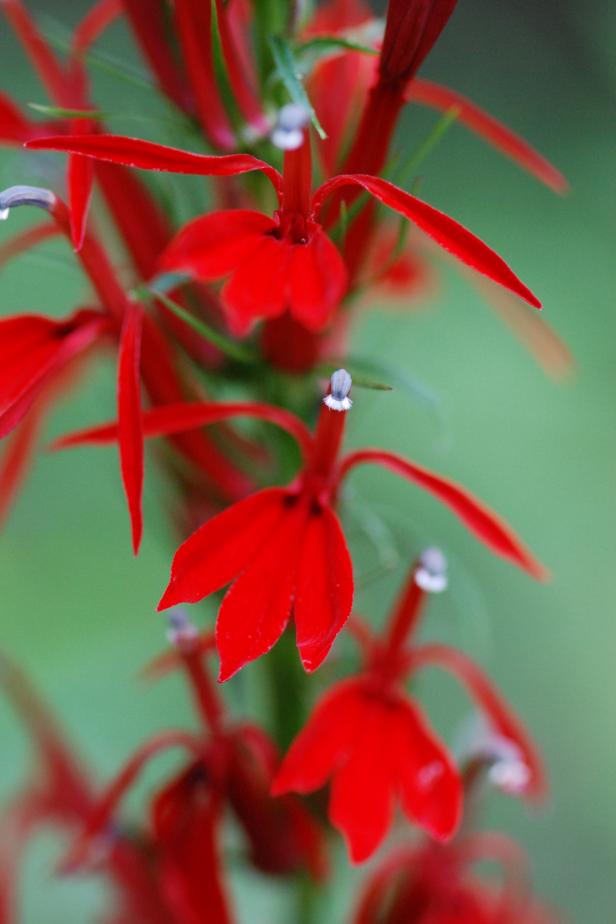
Image courtesy of East Tennessee Wildflowers
This stunning cardinal flower favors moist, shady woodland areas and attracts hummingbirds.
White Beardtongue — Penstemon digitalis produces lovely white tubular flowers that stand out against its red leaves. It attracts bees, butterflies and hummingbirds. It's also deer resistant
Joe Pye Weed — The tall Eutrochium purpureum can serve as a lovely backdrop for shorter flowers. The blooms are rich in nectar and the flowers can be dried and used for arrangements.
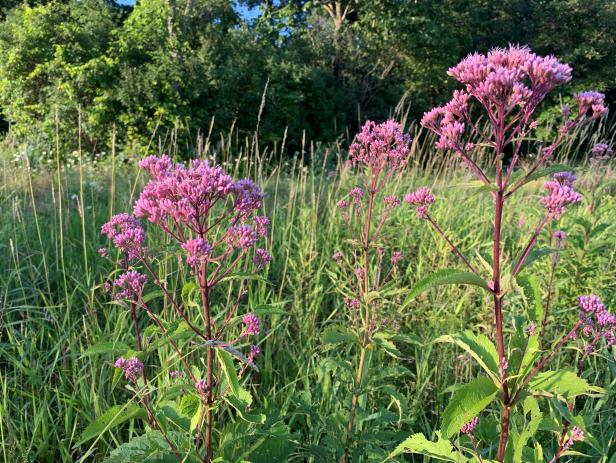
Kendall Frost/American Meadows
Plant Joe Pye weed, also called sweet Joe Pye weed, in masses for the best display of color.
Swamp Milkweed — Asclepias incarnata features nectar-rich flowers that nourish pollinators, including butterflies of all kinds, honey bees, native bees and hummingbirds. The flat to spherical flowers measure 2 to 4 inches across and offer 20 or more florets per bloom.
Rose Mallow — Hibiscus moscheutos, aka Swamp Mallow, grows 4 to 6 feet tall and 3 to 4 feet wide. It features flowers as large as dinner plates in white, pink, red and sometime bicolor blends.






